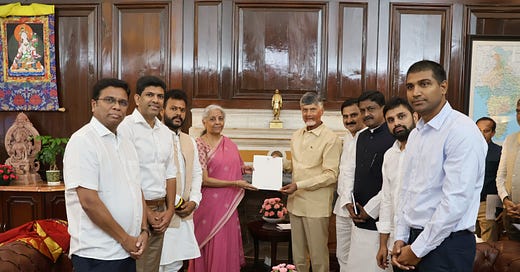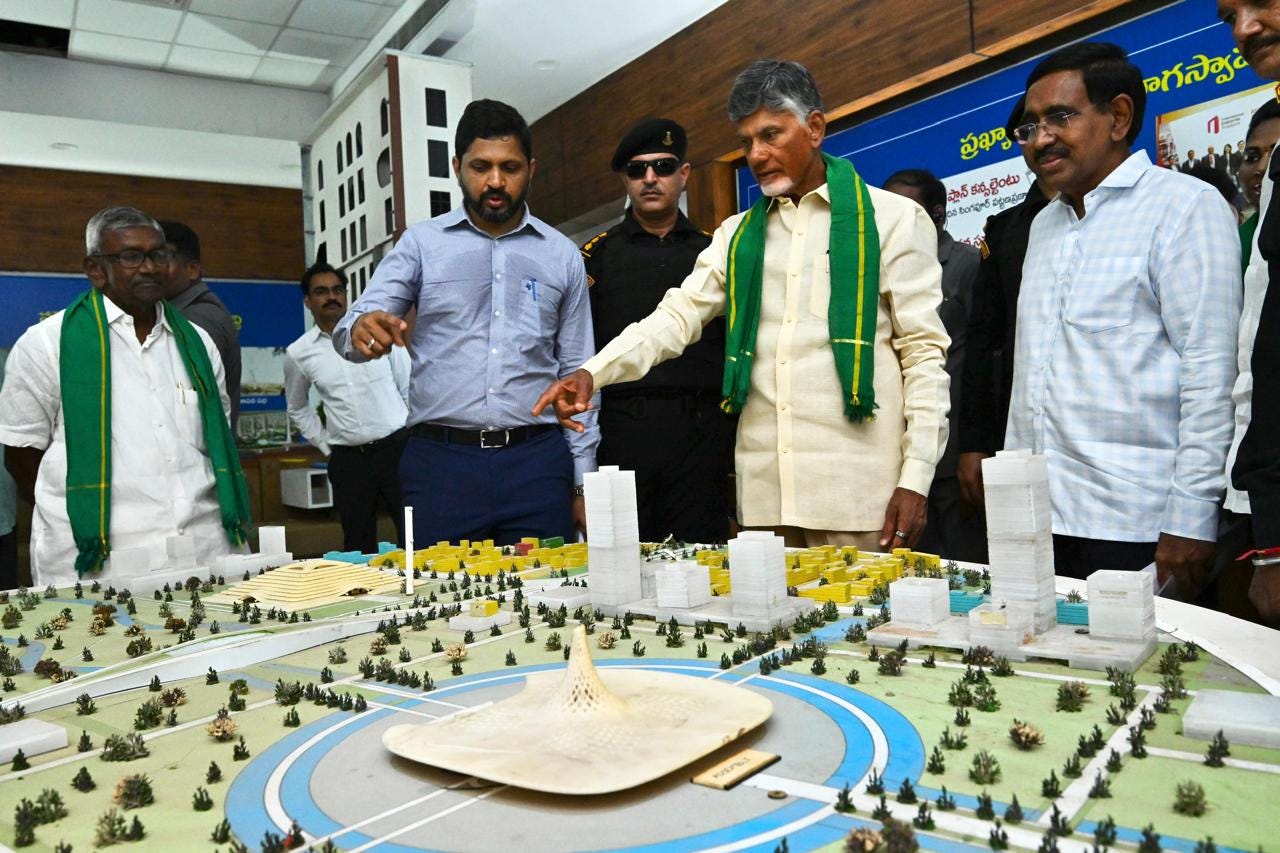Chandrababu Naidu’s New Fertile Idea: More Kids for a Thriving Andhra Pradesh
Chandrababu Naidu’s concerns shouldn’t be dismissed as mere rhetoric; they represent the starting point for a broader, rational discussion that rises above regional concerns.
Is the Population Facing a Reverse Countdown in Southern States?
Introduction
Andhra Pradesh Chief Minister N Chandrababu Naidu (CBN) ignited an animated debate with his remarks in public gathering in West Godavari district, a message he reiterated on Saturday (19th October) at an event in Amaravati. Naidu urged families in the state to have more children—a controversial position that directly challenges decades of population control policies in India. His concerns stem from the state’s declining birth rates and an ageing population, which he believes could undermine Andhra Pradesh’s socio-economic future. Naidu’s appeal goes beyond addressing immediate demographic shifts, reflecting deeper anxieties about the long-term socio-economic stability of not only Andhra Pradesh but also other southern states grappling with similar challenges. His stance raises critical questions about the merits of encouraging population growth in regions with falling fertility rates—and what the broader implications of such a strategy might be.
Naidu’s Argument for More Population
At the core of CBN’s message is the belief that Andhra Pradesh, like other southern states, is witnessing a dangerous demographic shift—one that could cripple its future workforce and economic growth. Currently, Andhra Pradesh’s fertility rate stands at 1.7, significantly below the replacement level of 2.1, signalling a population that is shrinking rather than growing. This, Naidu believes, threatens the state’s ability to harness the much-touted demographic dividend, the phase during which a youthful workforce drives economic growth and innovation.
CBN argued that without a population boost, Andhra Pradesh risks entering a period of irreversible decline, where the elderly outnumber the young and the economy stagnates due to a lack of fresh manpower in all sectors of the economy. He highlighted that many villages in Andhra Pradesh are already populated largely by the elderly, as younger generations migrate to cities or overseas for better opportunities. This trend, if unchecked, could render rural economies, still dependent on labour -intensive agriculture, unsustainable and lead to a massive socio-economic imbalance within the state.
To address this, Naidu has proposed offering incentives for larger families and controversially suggested that only individuals with more than two children should be eligible to contest local body elections. His rationale is straightforward: a larger population would ensure a continuous supply of workers, bolster the state’s competitiveness, and sustain economic growth in the long term. Naidu emphasises the urgent need to reverse current demographic trends, as the window to harness the state’s youthful workforce is closing rapidly. Projections indicate that by 2047—ironically the same year by which Prime Minister Modi envisions India becoming a "Viksit Bharat" (developed nation)—India’s elderly population could surpass the younger working-age demographic, threatening the country’s economic momentum.
Ageing Population and Economic Impact
Naidu’s concerns are not entirely without merit. The decline in birth rates across southern states, including Andhra Pradesh, mirrors global trends in developed economies. The socio-economic impact of an ageing population is profound. With fewer young workers entering the workforce and a growing number of retirees, the burden on social welfare systems, healthcare, and pensions becomes heavier.
Moreover, the ageing population directly affects productivity and innovation. Younger generations are often the drivers of technological advancement and economic dynamism, while older populations tend to contribute less to the economy in terms of both labour and consumption. This has significant implications for Andhra Pradesh’s long-term competitiveness. Naidu’s argument that more children are needed to maintain economic momentum is thus rooted in the fear that the current trajectory could lead to a stagnating or even contracting economy, which would hurt infrastructure development, industrial growth, and employment generation.
Our illustrious IPS batchmate, K Rajendra Kumar, former Director General of Police, Jammu and Kashmir, and currently active in social sector NGOs in Hyderabad, highlighted the urgent relevance of population dynamics in today’s context. He pointed out that India’s demographic dividend, which has been a key driver of growth, will start to decline in the next 25 years. This, combined with an ageing and less productive population—similar to what China is experiencing—presents a significant challenge. He attributed this shift to Millennials increasingly opting for either a single child or no children, and the growing issue of infertility in both men and women. Echoing CBN’s views, Rajendra Kumar stressed that without a robust, forward-looking policy on population growth and control, the future may not be as promising as hoped.
Lok Sabha Seats and Delimitation
CBN’s argument for increasing Andhra Pradesh's population is not just about economic sustainability; it also ties directly into political representation at the national level. Andhra Pradesh currently holds 25 seats in the Lok Sabha, India’s lower house of Parliament, based on the 2001 Census and delimitation exercises conducted between 2002 and 2008. These seat allocations have remained frozen due to the 84th and 87th Amendments, which postponed seat adjustments until 2026. However, this delay in recalibration poses a potential risk for states like Andhra Pradesh.
The current population estimate for Andhra Pradesh, after its bifurcation, stands at approximately 52.88 million, giving each Lok Sabha seat a representation of about 21.15 lakh people. In comparison, states like Uttar Pradesh and Bihar, with populations of 257.05 million and 130.72 million, respectively, have a much higher population per seat—over 32 lakh per constituency. This means that while Andhra Pradesh and other southern states are currently over-represented in terms of population per seat, the next delimitation, expected after 2026, could significantly shift the political balance in favour of northern states like Uttar Pradesh and Bihar, which already hold a greater number of seats due to their larger populations.
For Naidu, this looming recalibration further underscores the need to bolster Andhra Pradesh's population. His call for more children can be seen as an effort to ensure that the state does not lose political influence at the national level when the next delimitation takes place. If Andhra’s population continues to decline relative to northern states, the so-called progressive southern states could find themselves with relatively less representation in Lok Sabha, and consequently, less influence in in the national politics as well as in determining how national resources are distributed and how regional interests are protected.
Central Finance Commission and Devolution of Taxes
Beyond political representation, population figures play a crucial role in determining the share of central taxes allocated to each state. The 15th Finance Commission used a devolution formula that assigned 15% weightage to population (based on the 2011 Census), 45% to income distance, 15% to geographical area, and smaller percentages to criteria like demographic performance and forest cover. States with larger populations, like Uttar Pradesh, inherently receive a larger share of central taxes, while states with lower populations, like Andhra Pradesh, could see a decline in their fiscal share.
This has created friction, especially in southern states, which argue that they are being penalised for successfully controlling their population growth. Tamil Nadu Chief Minister M K Stalin has frequently voiced concerns that the Centre’s approach to tax devolution disproportionately benefits northern states with higher birth rates. CBN’s push for higher population growth can thus also be seen as an attempt to secure Andhra Pradesh’s fiscal future, ensuring that it remains a significant player in the distribution of central resources.
A Contradiction to Population Control Policies?
Naidu’s push for larger families starkly contrasts with India’s long-standing population control measures. For decades, the national slogan "Hum Do, Humare Do" ("We Two, Ours Two") encapsulated India’s commitment to curbing its rapid population growth. The success of these policies is evident in states like Kerala, Tamil Nadu, and Andhra Pradesh, where fertility rates have dropped well below replacement levels.
Critics argue that Naidu’s stance is regressive and undermines the progress made in controlling population growth, particularly in a country where high population density has historically strained resources like land, water, and energy. Promoting larger families, they argue, could exacerbate issues of resource scarcity, especially in a state where water management is already a contentious issue.
Gender and Social Implications
Another dimension of the controversy surrounding Naidu’s call for more children is the gendered impact of such a policy. Encouraging larger families may place disproportionate pressure on women, who are traditionally expected to bear the responsibility of child-rearing. This could roll back gains made in gender equality, especially in terms of women’s participation in the workforce and their access to education. With women striving for greater economic independence, urging them to have more children could be seen as regressive, reinforcing patriarchal expectations and limiting their life choices.
Moreover, with more children comes the need for more resources in terms of education, healthcare, and infrastructure. Naidu’s proposal has yet to address how the state will provide for these additional demands in a way that does not further strain existing resources.
The Larger National Context: North-South Divide
Naidu’s argument takes place against the backdrop of a growing demographic and political divide between southern states and the populous Hindi-speaking northern states. While Andhra Pradesh, Tamil Nadu, and Kerala are grappling with ageing populations and declining fertility rates, states like Uttar Pradesh and Bihar continue to experience high birth rates. This demographic divergence has serious implications for the distribution of political power and fiscal resources.
Tamil Nadu Chief Minister M K Stalin, as stated before, has frequently voiced concerns that southern states, despite their success in population control, are being penalised in terms of fiscal transfers from the Centre. States with high populations, like Uttar Pradesh, benefit from a greater share of central taxes and political representation, while states that have controlled their population growth are allocated fewer resources. This imbalance could fuel resentment between the north and south, potentially leading to a deepening of regional divides.
Rethinking Fiscal and Political Allocations: A National Imperative
The Need for a New Equitable Balance
Chief Ministers like N Chandrababu Naidu and M K Stalin have stressed the urgent need for a re-evaluation of India’s political representation and fiscal allocation frameworks. Rather than focusing solely on population size, these frameworks should also take into account demographic performance. With the federal structure already facing strain, a careful rebalancing is essential to prevent further widening of the north-south divide, which could escalate inter-state tensions and undermine the country's unity.
Building Consensus Before 2026: A Central Government-Led Dialogue
To avoid these tensions, a nationwide dialogue must be initiated, led by the central government, to build consensus before the next round of devolution in 2026. This requires both formal and informal input from the current Finance Commission, ensuring that the issues of representation and resource distribution are addressed comprehensively. Chandrababu Naidu’s concerns shouldn’t be dismissed as mere rhetoric; they represent the starting point for a broader, rational discussion that rises above regional biases1.
India’s Global Role in Tackling Population Decline
Looking beyond India’s borders, the country has an opportunity to position itself as a potential solution to the global population decline—a concern famously raised by Elon Musk. As Europe has aged and China faces the consequences of its one-child policy, India’s youthful population offers a unique advantage. By addressing its own demographic challenges, India can simultaneously position itself as a global contributor, helping to offset the looming population implosion that threatens global stability.
A Call for Collective Action
This issue transcends state or regional interests. All stakeholders—governments, economists, and civil society—must come together to formulate strategies to prevent the slow decline of rural India and address the broader demographic challenges facing the world. With coordinated and thoughtful action, India can not only safeguard its own socio-economic stability but also contribute to sustaining global demographic health.






